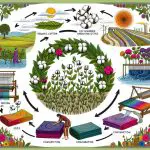It's a coincidence that you're here, just as sustainable fashion is gaining momentum. By understanding the eco-friendly fabric lifecycle, you'll see how each step, from sourcing renewable materials to end-of-life management, plays an essential role in minimizing environmental impact. This journey begins with ethical farming practices and extends to responsible manufacturing and versatile fabric use. As you explore this topic, you'll uncover why composting, recycling, and upcycling are vital for a truly sustainable wardrobe. Curious about how these components interconnect to create a greener fashion industry? Let's explore further.
Table of Contents
Key Takeaways
- Sustainable raw materials and ethical farming promote eco-friendly textiles and healthy ecosystems.
- Closed-loop production systems and water recycling reduce waste and support the circular economy.
- Durable, versatile fabrics and multi-purpose garments minimize waste and environmental impact.
- Responsible end-of-life management, including composting and biodegradable options, reduces landfill waste.
- Recycling and upcycling conserve resources and reduce energy consumption compared to new fabric production.
Raw Material Sourcing
Eco-conscious fabric starts its journey with the mindful sourcing of sustainable raw materials. You'll recognize the importance of ethical farming and responsible gathering as the foundation for creating eco-friendly textiles. Ethical farming guarantees that crops like organic cotton and bamboo are grown without harmful pesticides or synthetic fertilizers, promoting healthier ecosystems and safer working conditions for farmers.
Next, focus on the role of renewable resources in this process. Sustainable textiles often come from natural fibers such as hemp, flax, and Tencel, which aren't only biodegradable but also require less water and energy to produce. By choosing these fibers, you support an industry that prioritizes environmental stewardship and resource conservation.
Responsible gathering is another critical aspect. For instance, when harvesting cork or bamboo, the plants aren't destroyed but carefully cut to allow for regrowth. This method ensures that the raw materials are continuously renewable, reducing the need for deforestation and habitat destruction.
Sustainable Fabric Production
Once the raw materials are sourced responsibly, the next step is making sure that the fabric production process itself follows sustainable practices. You need to focus on ethical manufacturing, which prioritizes fair labor conditions and minimizes environmental impact.
By using renewable resources like plant-based dyes and solar energy, you can greatly reduce the carbon footprint of fabric production.
Consider adopting closed-loop systems and recycling water used in dyeing processes. These practices align with the principles of a circular economy, where waste is minimized and materials are continuously repurposed. By doing so, you not only conserve resources but also contribute to reducing pollution and waste.
Transparency is essential. Make sure that every stage of production is traceable, from yarn spinning to fabric finishing. This not only builds consumer trust but also enables you to identify and rectify any unsustainable practices swiftly.
Eco-Friendly Fabric Use
When it comes to using eco-friendly fabrics, choosing pieces that are durable and versatile guarantees you get the most out of them while minimizing waste. By prioritizing sustainable fashion, you actively reduce your environmental impact.
Start by selecting garments that serve multiple purposes and can be styled in various ways. This approach not only maximizes your wardrobe's potential but also cuts down on the frequency of purchases, reducing the demand for resource-intensive production.
Pay attention to care labels and follow washing instructions meticulously. Eco-friendly fabrics often require less water and milder detergents, which further lessens your environmental footprint. Air-drying your clothes instead of using a dryer conserves energy and extends the lifespan of your garments.
Moreover, repair and upcycle whenever possible. A small tear or a missing button shouldn't mean the end of a garment's life. Learning basic sewing skills can keep your sustainable fashion items in rotation longer, thereby decreasing waste.
End-of-Life Management
At the end of their lifecycle, eco-friendly fabrics should be responsibly disposed of to minimize environmental impact. You can achieve landfill diversion by exploring composting and incineration alternatives. Composting is ideal for biodegradable options like organic cotton or hemp. These materials break down naturally, enriching the soil rather than contributing to waste.
Consider the following disposal methods:
| Disposal Method | Description |
|---|---|
| Composting | Organic fabrics decompose naturally, returning nutrients to the soil. |
| Incineration Alternatives | Use processes like pyrolysis, which converts fabrics into usable energy without harmful emissions. |
| Biodegradable Options | Choose materials designed to break down quickly and safely, reducing the long-term environmental footprint. |
By prioritizing these methods, you actively contribute to reducing the volume of waste that ends up in landfills. Incineration alternatives like pyrolysis offer a sustainable way to handle non-compostable fabrics, converting them into energy with minimal environmental harm. Always opt for biodegradable options when selecting new fabrics, ensuring they won't linger in ecosystems for centuries.
Being mindful of end-of-life management not only helps the planet but also sets a standard for responsible consumption. You're not just disposing of fabric; you're closing the loop on sustainability.
Recycling and Upcycling
Recycling and upcycling breathe new life into eco-friendly fabrics, turning potential waste into valuable resources. When you embrace these practices, you're not just reducing waste but also paving the way for a circular economy.
Creative repurposing lets you transform old garments or fabric scraps into new, fashionable items, contributing to sustainable fashion.
Imagine the impact you can make:
- Reduce landfill waste: By recycling, you keep textiles out of landfills, where they'd otherwise take years to decompose.
- Conserve resources: Upcycling uses existing materials, meaning fewer natural resources are needed to create new products.
- Lower carbon footprint: Recycling fabric reduces the energy required compared to producing textiles from raw materials.
- Inspire innovation: Your creative repurposing efforts can inspire others to think differently about waste.
- Support ethical fashion: Embracing these practices aligns with sustainable fashion principles, promoting a healthier planet.
Frequently Asked Questions
How Do Eco-Friendly Fabrics Compare in Cost to Traditional Fabrics?
When you compare the cost of eco-friendly fabrics to traditional ones, you'll notice eco-friendly options can be pricier. However, considering their positive environmental impact, the higher cost often justifies the long-term benefits.
Are There Certifications to Identify Genuinely Sustainable Fabrics?
Yes, you can rely on certification standards like GOTS, OEKO-TEX, and Fair Trade to confirm fabric authenticity. These certifications help you identify genuinely sustainable fabrics, giving you confidence in your eco-friendly choices.
Can Eco-Friendly Fabrics Affect Skin Sensitivity or Allergies?
You might be wondering if eco-friendly fabrics affect skin sensitivity or allergies. Surprisingly, fabric composition can indeed cause skin reactions. Sustainable textiles often use natural fibers, which can be gentler, but always check for personal allergies.
How Does Fabric Transportation Impact Overall Sustainability?
Fabric transportation greatly impacts overall sustainability. You must consider the carbon footprint and environmental impact. Optimizing the supply chain and focusing on emissions reduction are vital steps to minimize negative effects and enhance eco-friendly practices.
What Are the Best Practices for Storing Eco-Friendly Fabrics?
Think of storing eco-friendly fabrics like preserving a fine wine. Proper care guarantees longevity. Keep them in cool, dry places, away from sunlight. Use breathable storage materials. Treat them well, and they'll serve you beautifully for years.
- Why Open-Weave Scrim Is the Secret to Stunning Event and Canopy Designs - June 26, 2025
- Creating Large-Scale Art Installations With Scrim Fabric - June 26, 2025
- Scrim Fabric in Upholstery: Understanding Its Use as a Backing Material - June 26, 2025






